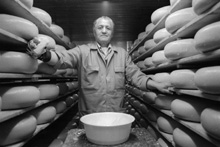Migrant workers > The digital collection
Wherever necessary, the selected negatives and prints were remounted and numbered. Inventory numbers were maintained and negatives were numbered by sheet, from left to right and from top to bottom. Every negative was given a number consisting of an inventory number and, in most cases, a number of serial numbers. The corresponding descriptions were entered in the Memorix online database and then transferred to The Memory.
Pros and cons
An important advantage of digitization is that the original object is less subject to handling and, consequently, there is less risk of the fragile material getting damaged. However, a scan (or print) of a negative does not necessarily convey the same image as the photographer himself had in mind. Photographers are able to influence the final print to a great extent in the traditional darkroom. Most files underwent some limited processing (framing of the entire negatives, histogram and curve), but were not touched up. Only the photographs taken by Bertien van Manen were thoroughly processed under her own supervision.
The negatives were scanned by means of an Imacon Flextight 848/X1 and a Hasselblad X1 negative scanner with Flexcolor. The negatives were processed in Adobe Photoshop (version CS 3) and are on view here as JPEG, maximum size 1200 pixels wide (resolution 72 DPI). The master files are 16 bit TIFFs of maximum 45 centimeter (resolution 300 DPI). The files were partly processed (framing of the entire negative, histogram and curve), but not touched up.
All the photographs are also accessible through the website of the Nederlands Fotomuseum (Dutch Photography Museum) and may be ordered for professional use.

